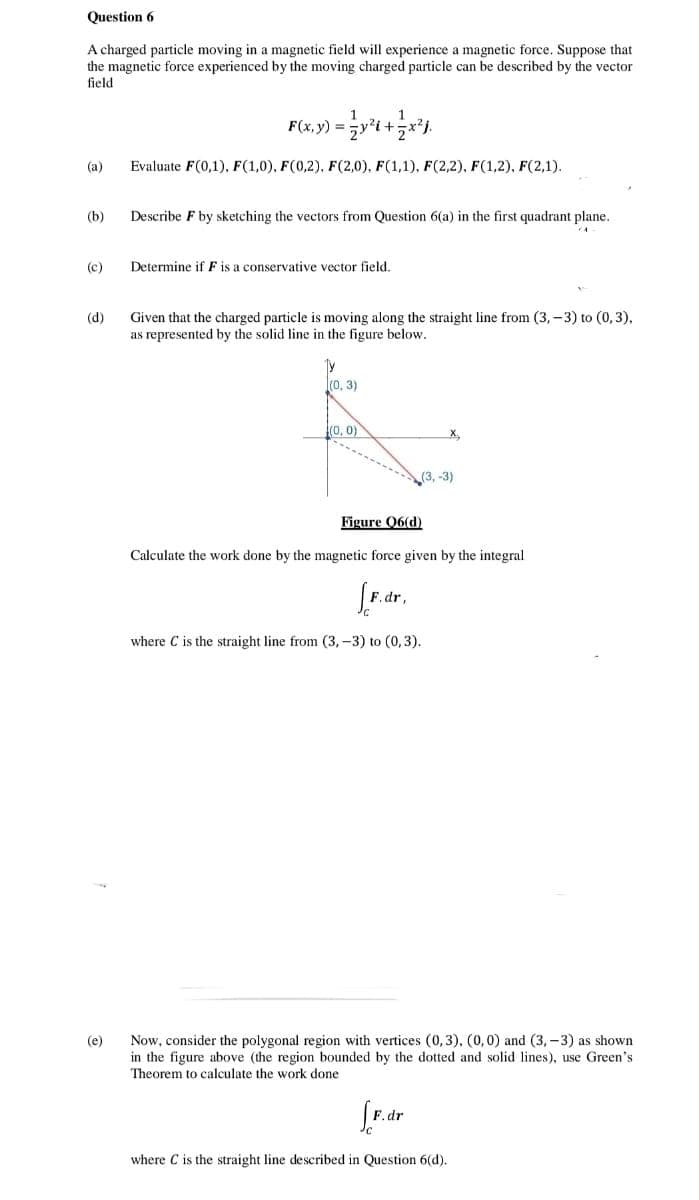A charged particle moving in a magnetic field will experience a magnetic force. Suppose that the magnetic force experienced by the moving charged particle can be described by the vector field F(x, y) = y't + (a) Evaluate F(0,1), F(1,0), F(0,2). F(2,0). F(1,1), F(2,2), F(1,2), F(2,1). (b) Describe F by sketching the vectors from Question 6(a) in the first quadrant plane. (c) Determine if F is a conservative vector field.
A charged particle moving in a magnetic field will experience a magnetic force. Suppose that the magnetic force experienced by the moving charged particle can be described by the vector field F(x, y) = y't + (a) Evaluate F(0,1), F(1,0), F(0,2). F(2,0). F(1,1), F(2,2), F(1,2), F(2,1). (b) Describe F by sketching the vectors from Question 6(a) in the first quadrant plane. (c) Determine if F is a conservative vector field.
Algebra & Trigonometry with Analytic Geometry
13th Edition
ISBN:9781133382119
Author:Swokowski
Publisher:Swokowski
Chapter8: Applications Of Trigonometry
Section8.4: The Dot Product
Problem 32E
Related questions
Question
Please solve a,b and c part correctly in one hour please show neat and clean work

Transcribed Image Text:Question 6
A charged particle moving in a magnetic field will experience a magnetic force. Suppose that
the magnetic force experienced by the moving charged particle can be described by the vector
field
F(x, y) =
(а)
Evaluate F(0,1), F(1,0), F(0,2), F(2,0), F(1,1), F(2,2), F(1,2), F(2,1).
(b)
Describe F by sketching the vectors from Question 6(a) in the first quadrant plane.
(c)
Determine if F is a conservative vector field.
Given that the charged particle is moving along the straight line from (3, - 3) to (0,3),
as represented by the solid line in the figure below.
(d)
(0, 3)
(0, 0)
X,
(3, -3)
Figure 06(d)
Calculate the work done by the magnetic force given by the integral
F.dr,
where C is the straight line from (3,-3) to (0,3).
Now, consider the polygonal region with vertices (0, 3), (0,0) and (3, - 3) as shown
in the figure above (the region bounded by the dotted and solid lines), use Green's
Theorem to calculate the work done
(e)
where C is the straight line described in Question 6(d).
Expert Solution
This question has been solved!
Explore an expertly crafted, step-by-step solution for a thorough understanding of key concepts.
Step by step
Solved in 3 steps with 1 images

Recommended textbooks for you

Algebra & Trigonometry with Analytic Geometry
Algebra
ISBN:
9781133382119
Author:
Swokowski
Publisher:
Cengage

Algebra and Trigonometry (MindTap Course List)
Algebra
ISBN:
9781305071742
Author:
James Stewart, Lothar Redlin, Saleem Watson
Publisher:
Cengage Learning

Elementary Linear Algebra (MindTap Course List)
Algebra
ISBN:
9781305658004
Author:
Ron Larson
Publisher:
Cengage Learning

Algebra & Trigonometry with Analytic Geometry
Algebra
ISBN:
9781133382119
Author:
Swokowski
Publisher:
Cengage

Algebra and Trigonometry (MindTap Course List)
Algebra
ISBN:
9781305071742
Author:
James Stewart, Lothar Redlin, Saleem Watson
Publisher:
Cengage Learning

Elementary Linear Algebra (MindTap Course List)
Algebra
ISBN:
9781305658004
Author:
Ron Larson
Publisher:
Cengage Learning

College Algebra
Algebra
ISBN:
9781305115545
Author:
James Stewart, Lothar Redlin, Saleem Watson
Publisher:
Cengage Learning